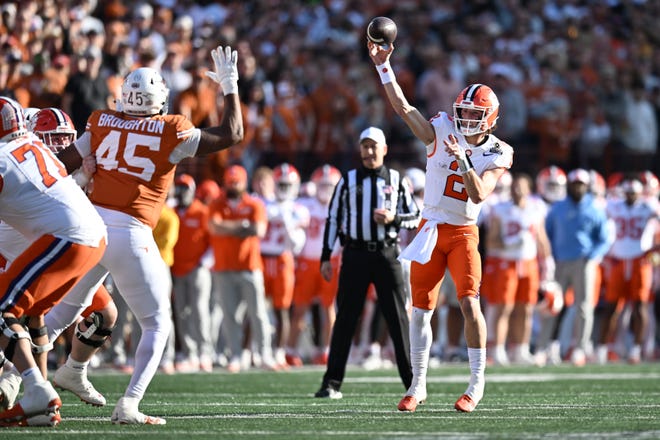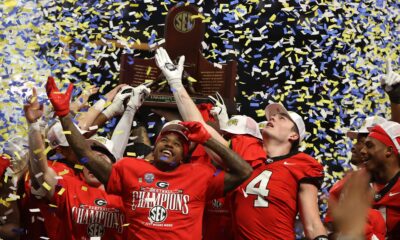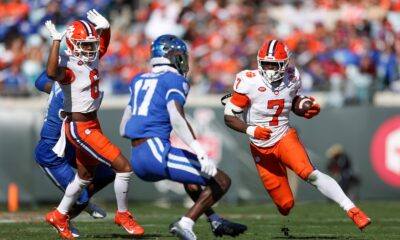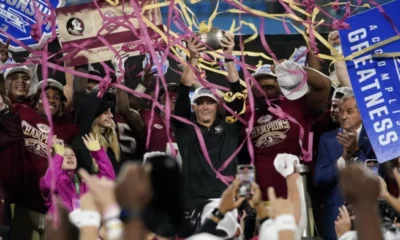
This is the yearly article about Clemson’s season that I write every year.
In last year’s review, I wrote that the opener against Georgia had the potential to affect the long-term national perception of the program. On opening weekend, the eyes of the entire nation witnessed Georgia bury Clemson under a 2nd half barrage of big plays, 34-3. This became the season defining game, that much like Auburn 2010, the team would never really recover from. Wait, scratch that.
Clemson would go on to dominate their next 6 opponents and position themselves as a playoff contender. The season defining game would actually come on 11/2/24 when (6-1) Clemson was physically hammered by an underdog Louisville team under the lights at night in Death Valley. Fans rained bottles down onto the field in disgust as the Tigers’ pursuit of the ACC title and CFP died. Wait, scratch that.
The game that actually defined the season would be when the #12 (9-2) Tigers suffered a last minute home loss to archrival South Carolina. The Gamecocks were able to end the Tigers’ season by knocking them out of the playoff for the 2nd time in 3 years. Wait, scratch that.
Syracuse upset Miami in the final game? The Tigers are in the ACC title game? And they went on to beat SMU? And now they’re in the playoff?
The 2024 Clemson season was a rollercoaster where The Tigers were left for dead multiple times. Parity and fortunate breaks ended up giving the Tigers a 4th chance at a successful season. When that last second 56-yard FG against SMU delivered an ACC Championship and a return to the college football playoff for the first time since 2020, a season’s worth of rug pulling was made good.
However, we all knew this was more smoke and mirrors than genuine validity. The prevailing theme of the 2024 Tigers is that they were unable to scale up against better competition. The reason for this was the same reason the Tommy Bowden teams were also inconsistent. While Clemson had comparable athletes to the best teams on their schedule, they profiled as a finesse team.
Against the 4 ranked opponents they played, Clemson averaged 2.73 yards per carry rushing (81.25 ypg / 2 TDs) and gave up 5.80 yards per carry (220.50 ypg / 9 TDs). For comparison purposes, here are the same numbers for the 2018 National Championship team. Against 4 ranked: Offense | 4.93 ypc (188.50 ypg / 8 TDs). Defense | 2.83 ypc (92.00 ypg / 2 TDs).
Against their 10 unranked opponents, Clemson averaged 5.81 yards per carry (210.20 ypg / 21 TDs) and gave up 4.21 yards per carry (136.70 ypg / 9 TDs). Again, for comparison purposes, here are the same numbers for the 2018 National Championship team. Against 10 unranked: Offense | 7.15 ypc (269.91 ypg / 41 TDs). Defense: 2.41 ypc (97.82 ypg / 6 TDs) (credit cfbstats.com)
There is a huge chasm between 2018 and 2024 in physicality up front against ranked competition. This is the primary statistical indicator of why Clemson 2024 could not compete on the elite level. We’re talking about 3 yards per carry of difference on both sides of the ball every time a run play was called. Absolutely massive. Comparing the 2018 and 2024 teams, you can see that this manifests into a 14 total TD swing on the ground in the 4 games against ranked teams. 14!
This huge chasm in physicality reveals how far away Clemson actually is from a return to the elite level.
One place this repeatedly showed up was in the inability to play keep-away with the run game when The Tigers had a lead. Against Pitt, South Carolina, and SMU, the Tigers had control of the game heading into the 4th quarter and then the offense delivered multiple 3 and outs in a row. The Tiger defense would tire out and give up the lead. Then, the sputtering offense would be responsible for opening the playbook back up and generating last minute heroics to save the game. Needless to say, this is not the ideal formula for victory.
The ideal formula is that the Tigers can move the ball on the ground, run the clock, shorten the game, rest the defense, and limit the number of remaining opponent offensive possessions. If the opposing defense chooses desperation and sells out to stop the run, it then makes it easier to hit a game-sealing big play in the play-action passing game. We saw this between 2015 and 2020, but did not see it in 2024.
The lack of physicality on both sides of the ball brings back into question the strength and conditioning program. Much maligned during the first 6 years of Dabo’s tenure, Dabo made changes to the S&C program in the early 2010s. After 6 straight playoff appearances, we thought this issue was put to bed. However, with strength and toughness being a team-wide problem now, this issue must be addressed by the staff this offseason.
A much heralded addition to the coaching staff this year was renowned OL guru, Matt Luke. While we definitely saw improvement in the overall body of work of the OL in his first year, especially in sacks allowed, pressure rate, and creating viable depth behind the starters, it is clear there is still much work to be done. I’m hoping that competition from that viable depth and improvements in S&C help push the OL performance to the next level in 2025.
The brightest light on the offensive side of the ball in 2024 ended up being the biggest question mark coming into the season, QB1 Cade Klubnik. After the Georgia game, many Tiger fans wanted the star of the spring game, Trent Pearman, to get a look at QB. Instead, Klubnik got a public vote of confidence from Coach Swinney and delivered a very strong 2024 campaign. The mental gaffes, poor decision making, and hero-ball that plagued him in 2023 were largely gone.
Klubnik’s ability to read defenses and take what they were giving him got better and better as the season went on. His legs also became a weapon. By the end of the season, he proved he was comfortable performing against a couple of the best defenses in the country. Klubnik finished 2nd in the nation with 37 TD passes and 13th nationally in Total QBR. He saved his best performance for last when he went 26/43 for 336 yards, 3 TDs, and 1 INT in the CFP loss against the #1 ranked Texas pass defense.
Helping Klubnik greatly was, something we haven’t had in several years, an infusion of better WR talent. The return of Antonio Williams coupled with true freshmen impact players, Bryant Wesco and T.J. Moore, gave the Tigers a formidable receiving corps. With Klubnik and the WR corps returning for 2025, along with 4 of 5 starters on the OL, expectations for the offense will be the highest they have been since Trevor Lawrence’s 3rd and final season.
On the defensive side of the ball, the sentiment is not as positive. After giving up more than 6.0 yards per carry against Georgia, Louisville, South Carolina, and Texas, most Tiger fans are ready for the change that is coming in defensive leadership.
The Tiger D had major issues in fundamentals like tackling, gap integrity, and leverage. There is no way to absolve the coaches from responsibility when a team has poor fundamentals. While there was a substantial hole that needed patching at one of the DE spots, this was a group with a lot of returning talent that underachieved. The overall production of the defense ended up performing below the sum of its parts.
The most important defensive series of the year came in the 4th quarter against Texas in the playoff. Clemson cut a 21 point Texas lead down to 7, 31-24, with 11:43 left in the 4th quarter. A defensive stop would give a hot Clemson offense the chance to tie the game. On the 2nd play of the drive with the season on the line, The Tiger D gave up a 77-yard TD run on outside zone. Dagger.
Outside Zone Run (or Stretch) was a play Clemson had trouble stopping all season. It was also Texas’ staple play that they run more than any team in the country. Clemson had two weeks to find an answer, but was dominated over and over by this same play.
Coming off of a 31 yard rushing performance against Georgia in the SECCG, Texas’ 292 yards rushing yards against Clemson was a season high. Simply put, teams that compete on the highest level do not get physically dominated like this.
As disappointing as the defense was, special teams may have been the most disappointing phase in 2024. While special teams were a major contributor to the ACCCG win against SMU, they were a liability for the majority of the season. I’m not sure how you get 6 FGs blocked because of assignment confusion on the left side. How does that not get fixed after the first or second time? This went a long way to squander the ability of a very good true freshman kicker in Nolan Hauser.
Punting was not an advantage this season either as 6th year senior, Aiden Swanson, did not have as good a year as last year. He ranked 66th in punting average and Clemson finished 77th in net punting average for the season. As it often is, Clemson’s return game was no real threat either. The returners took care of the ball but ranked 59th in punt return average and 91st in kickoff return average. With the new staff rules, Clemson has proven there is a need to dedicate more coaching attention to special teams.
My research here shows that an Elite Program like Clemson will lose the perception of Eliteness after 7 consecutive years of non-elite performance. This is the 4th consecutive year of non-eliteness for Clemson. Why is that important?
When the perception of Eliteness is gone, we have seen the talent level drop an average of 49% in the recruiting rankings over the following 5 years. We have seen that the program will no longer receive opportunities from the CFP Committee (see Florida State 2023) and have to re-prove themselves on the highest level, usually over multiple seasons, to get it back. Despite winning games, those programs are removed from the year-long national discussion and get relegated back to just regional and state media.
Tiger fans think the de-commitments this year were bad. Wait until they stop even considering Clemson in the first place. Fans get mad when Paul Finebaum goes on SportsCenter and says, “Dabo’s dynasty is dead.” Well, three more years of non-eliteness and SportsCenter won’t even ask him about Clemson.
Coach Swinney has undoubtedly earned the right to do things his way. However, it’s takes a huge program-wide effort to do what Clemson did from 2015 to 2020. The critics are right that the head man is responsible for doing everything in his power to stay at the top in an ever-changing CFB landscape.
The experiment of giving unproven coaches the same chance that Coach Swinney once received from Terry Don Phillips has become an undeniable obstruction to maintaining elite level success. The transfer portal is a tool that can help, but the inexperienced coaching staff has been the main problem. (Click here for why the transfer portal is largely a red herring)
You can certainly have a guy or two that are in-house promotions. You can recognize their coaching potential and then micro-manage them and support them as they become more seasoned on the job, but you can’t micro-manage an entire staff learning on the job.
To Dabo’s credit, he began the course correction after the 2022 season. The hires Coach Swinney made in the past two years are a veritable “wish list” of top coaching talent. First time OC Brandon Streeter was replaced by the hottest OC in college football, Garrett Riley. First time OL coach, Thomas Austin, was replaced by OL guru, Matt Luke. First time DL Coach, Lemanski Hall, was replaced by former Alabama, Texas, Florida, Tennessee, Bears, and Vikings co-DC/DL coach, Chris Rumph.
These hires, and the use of the transfer portal to get Will Heldt, Jeremiah Alexander, and Tristan Smith, are the two tangible things one can point to as evidence that the Clemson program is gradually shaking off the complacency preventing them from competing on the Elite level since 2021. I can’t fully prove the complacency is gone, but it has started to feel like that Coach Swinney doesn’t like where the program is and is finally mad about it.
With the talent returning for Clemson in 2025 (and also likely losing heading into 2026), 2025 is “the year.” The expectations for Clemson are that they will have a better year than they did in 2024 and potentially return to the elite level by making the Semifinals of the CFP.
I’m dividing the 2025 regular season goals into two subsets. First, I see Clemson as likely having to do 2 of the 3 following things to earn a better opportunity in the CFP than they had in 2024: Beat LSU, Beat South Carolina, and win the ACC Championship. Sure, just winning the ACC will get them in, but the confidence level of what they can accomplish when they are there is vital. Clemson hasn’t beaten an Elite Team since Notre Dame in 2020 and no players are around that played in that game.
The second subset is the improvement needed in physicality at the line of scrimmage. No matter what The Tigers do during the season, they are going to have to bridge the gap in physicality to do something special in the CFP.
Lastly, it should be remembered by Tiger fans that Clemson under Dabo has always operated differently than the rest of the top programs. The college football landscape has changed, but the majority of Dabo’s formula from 2015-2020 still works. Rev Share is the next shoe to drop this summer and will create even more parity among power 4 schools. When that goes down, coaching ability and player retention will be at a premium. The schools that can best develop and keep their players will regain the advantage in a world where every P4 school has a $20M player budget.
So, there is hope here. Let’s also remember that Dabo’s greatest accomplishment throughout his tenure at Clemson has been to assemble football minds with great ability to develop players. In the BCS/CFB eras, Clemson is the only school to win a National Championship with sub-top-10 talent and they did it twice. With Rev Share on the way and an elite-level coaching staff in place, Clemson would be in a great spot for a resurgence.













